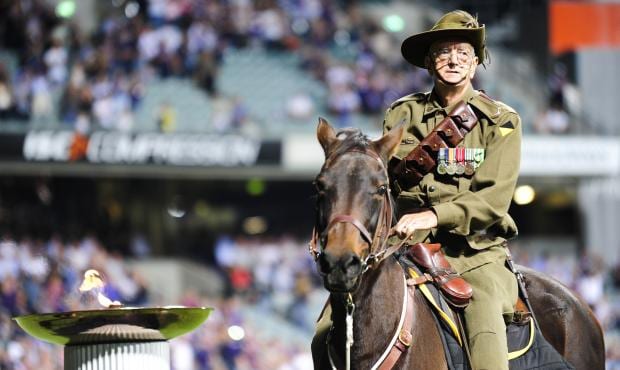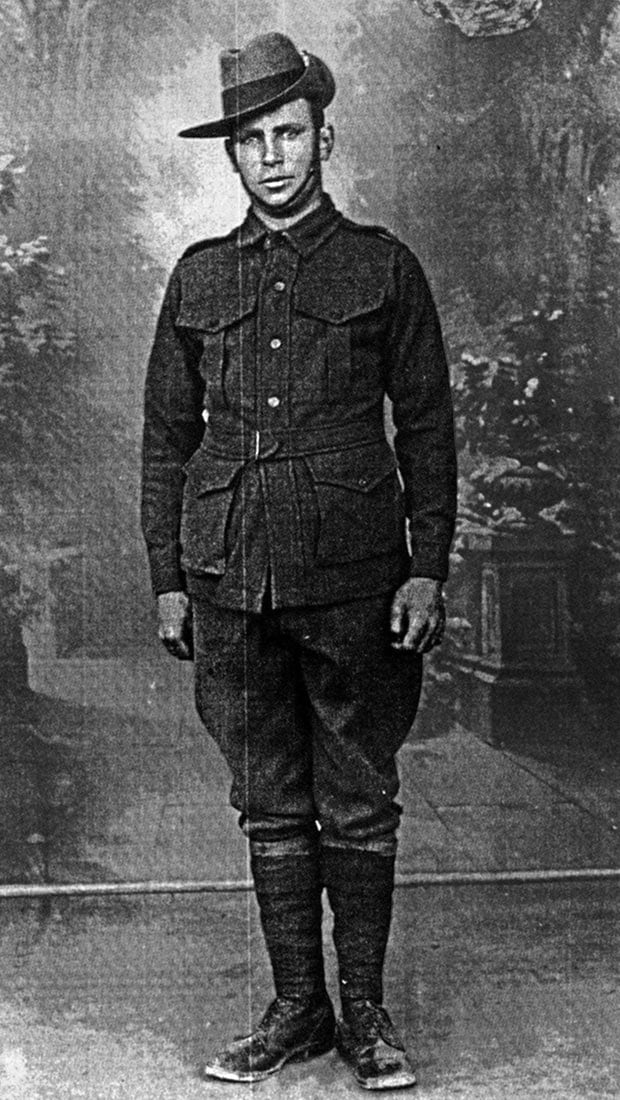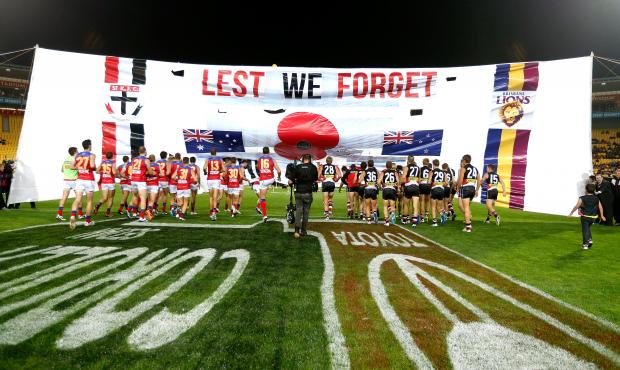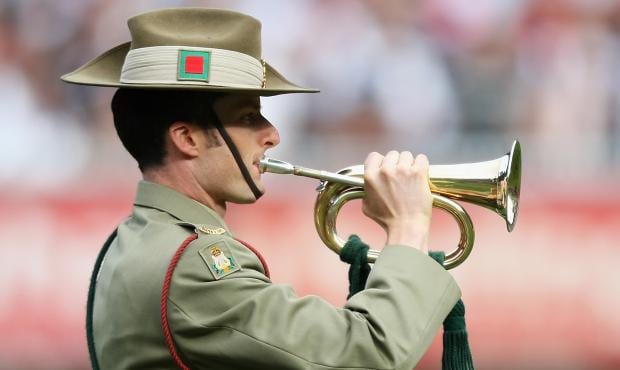WHEN it comes to football-related war stories, this one might be as eerie as it gets.
This Anzac round in New Zealand, St Kilda and Carlton are honouring two former players who were killed at Gallipoli 100 years ago, and the duo share an extensive list of uncanny links – in football, life and death.
In fact, you'd struggle to select another pair of fallen footballer/soldiers with more in common.
Fenley ‘Fen’ McDonald (who played for Carlton, and later, Melbourne) and Claude Crowl (St Kilda) made their League debuts against each other, and less than four years later were killed at Gallipoli on the same fateful day – April 25, 1915.
The coincidences don't end there – not by a long shot.
Both grew up on Victorian farms, were superb athletes, had short-lived careers in the then-VFL, mainly as backmen; had other family members who'd also played League football and served at war; were quick to join the first AIF (Australian Imperial Force) after the outbreak of World War I; and left Melbourne the same day but on different ships.
The Anzac flame is lit during one of last year's Anzac round matches in Perth. Picture: AFL Media

With some luck, McDonald and Crowl could also have been teammates.
Midway through the 1911 season they were actually training together at Carlton.
McDonald, who was born in Brunswick in Melbourne’s inner north but raised on a sheep and cattle farm at Nagambie (122km north of Melbourne), was the youngest of five brothers in a family of eight children.
He would be the third McDonald boy to play League football, following Edwin and Archie (15 and eight years his senior respectively), who made just one League appearance each – alongside each other for Essendon against Fitzroy in 1905.
In early 1911, Fen McDonald, then 19, moved to Melbourne to attend Stott and Hoare's Business College in Collins Street, and found a promising position as a stock and station agent a short walk away in Bourke Street.
Football was secondary, but the tough, well-muscled youngster starred with amateur club Carlton District and soon accepted an invitation from the Blues.
Fen McDonald in uniform, in a photo taken circa 1914. Picture: Supplied

At some point, Crowl – 19 months McDonald’s junior – joined him at Princes Park.
Born at the National Bank in Stratford, near Sale in Gippsland in Victoria’s east, on Boxing Day in 1892, Crowl briefly attended Caulfield Grammar, where he impressed in athletics. (McDonald was also a handy sprinter.)
Crowl was also a member of the Trinity Church Choir. (Both belonged to the Presbyterian denomination.)
This is where the synchronicity between Crowl and McDonald is nothing short of remarkable.
The ring-in earns a Carlton debut
Crowl's League debut came about in extraordinary circumstances, sharing some parallels with Essendon's top-up players in this year's NAB Challenge.
On the Tuesday before round 15, 1911, there was a sensation at St Kilda when 18 players went on strike over a dispute with the club's committee.
On the Thursday night, the committee threw open the gates for 50 lower-league hopefuls to press claims for a rare opportunity at the highest level just two days later.
Crowl was one of eight players – some of whom hailed from local clubs like South Yarra and Glenhuntly – to be selected as replacement players for the ‘Tricolours’.
As fate would have it, Crowl made his League debut against his Carlton training mates at Princes Park.
Even more amazingly, McDonald was also selected to play his first game that day. No mean feat given the Blues had contested the previous five grand finals.
McDonald kicked one of Carlton's 18 goals in a 114-point win over its undermanned, inexperienced opponent. However, it wasn't enough to keep the 20-year-old in the side, and it would prove his only League game for the season.
Meanwhile, Crowl played in three consecutive losses, by an average of 108 points, before the St Kilda players' strike ended and so did his League career.
Incidentally, only two of St Kilda's ring-ins remained with the club, one being an 18-year-old Roy Cazaly, who would later be named a Legend of the game.
St Kilda and Brisbane Lions players run through the banner ahead of last year's Anzac Day clash in New Zealand. Picture: AFL Media
McDonald played a further nine games for Carlton in 1912, and one for Melbourne in 1913, for a total of 11, before returning to Carlton District.
So at least World War I didn't interrupt their League careers, like it did so many others.
For King and country
Both men answered the call of King and country within weeks of the Allies entering the war – McDonald enlisting in Melbourne on August 17, 1914, and Crowl just eight days later at Surrey Hills.
One difference revealed in their service records was that Crowl (at 179cm and 76kg) was comfortably bigger than McDonald (171 and 70).
Quirkily, when McDonald filled out his enlistment form he regularly used exclamation marks.
Are you married? No!
Have you ever been convicted by the Civil Power? No!
They became privates in the first AIF – McDonald in the 7th Battalion and Crowl in the 8th – and both departed Melbourne on October 19, 1914, with McDonald aboard the Hororata and Crowl on the Benalla.
It's easy to imagine McDonald being reminded of his Carlton days while serving the country. His battalion leader was Lieutenant Colonel Harold ‘Pompey’ Elliott (later a famous general), whose nickname was a nod to Blues champion Fred ‘Pompey’ Elliott, briefly a teammate of McDonald's in 1911.
But things were mostly unfamiliar on this apparent overseas adventure.
On January 22, 1915, McDonald sent home a postcard from "the sandy desert of Egypt, just near the historical old Pyramids", describing it as "a dreary spot" but boasting that he'd climbed to the top of the oldest and biggest structure, the 140-metre tall Great Pyramid of Giza.
Less is known about Crowl's time in service, but what is certain is that he and McDonald lost their lives early in the Gallipoli campaign.
They were among six League footballers killed the day of the Anzac landings – April 25, 1915. The others were Rupert Balfe (University), Alan Cordner (Geelong and Collingwood), Charlie Fincher (South Melbourne) and Joe Pearce (Melbourne).
Two families in mourning
McDonald's service record reveals the heartache of those left behind.
After receiving the devastating news, McDonald's heartbroken father Patrick wrote to the defence department seeking details about his 23-year-old son’s demise, "as I have not heard how he fell and would so much like to know …" Alas, such details are unknown.
By the time McDonald's family learned his fate, one of his older brothers, Stanley, had already enlisted. However, Stanley would survive the war and live until 1945.
One of McDonald's great mates from the Melbourne business district, London-born Harold Denston, was alongside McDonald in B Company of the 7th Battalion and met a similar end. Denston was progressively reported as "missing", "wounded", "confirmed – wounded" and "wounded and missing", before it was determined he had been killed in action on April 25 – a process that took 13 months.
The same fate befell Crowl, the 22-year-old South Gippsland farmer.
Memory's wistful footsteps
The Crowl family received a brown paper parcel with his personal effects: a handkerchief, a gift tin purse, a metal watch and strap (damaged), a strop (razor strap) and a metal ring.
The McDonalds, meanwhile, were sent Fen's two wallets, letters, a diary, a Bible, a notebook, lenses and an antique ink-well.
Neither man has a known grave, but their names appear at the Lone Pine Memorial in Gallipoli.
Six League players were among the fallen on April 25, 1915 - the first day of the Gallipoli landings. Picture: AFL Media

A year after Crowl's passing, his family placed a memoriam notice in The Argus, honouring "our brave Claude…" On the 10-year anniversary of his passing, a mourner lamented:
And memory's wistful footsteps stray
By Anzac Cove, on Anzac Day.
Aggravating the agony of Crowl's family was news that two of his older cousins – both of whom also had brief League careers – were killed at Gallipoli too.
The first was Joseph Terrell Crowl junior (the middle name was shared by at least four other family members: the two ill-fated cousins and their fathers), who played four games for Geelong in 1906. The popular stock auctioneer was 31 when, as a much-admired captain in the Light Horse, he became the first officer from Geelong to be killed in action, when a shell claimed his life at Anzac Cove on June 27, 1915.
Claude Crowl's other unfortunate cousin was James Aitken, a 33-year-old 5th Battalion private who fell on August 8, 1915. In 1903, Aitken had been named in the centre for his one and only game for Geelong.
When the McDonald-Crowl tribute was announced in January, Saints coach Alan Richardson added a modern perspective to their joint sacrifice.
"What makes this especially powerful is that, sadly, St Kilda and Carlton have a direct link to Anzac Day through the deaths of past players Claude Crowl and Fen McDonald," Richardson said.
"It's quite incredible and humbling to think that 100 years ago to the day when we play our game in New Zealand, those two young men and many others were killed at Gallipoli. They were just 22 and 23 years of age, which is the average age of an AFL player."
League players killed on the first day of the Gallipoli landings
| Name | Club(s) | Rank and battalion | Age |
|---|---|---|---|
| Claude Crowl | St Kilda, 1911 | Private, 8th Battalion, AIF | 22 |
| Fenley McDonald | Carlton, 1911-12; Melbourne, 1913 | Private, 7th Battalion, AIF | 23 |
| Rupert Balfe | University 1909, 1911 | Lieutenant, 6th Battalion, AIF | 25 |
| Alan Cordner | Geelong, 1911-12; Collingwood, 1913-14 | Private, 6th Battalion, AIF | 24 |
| Charlie Fincher | South Melbourne, 1913 | Private, 5th Battalion, AIF | 23 |
| Joe Pearce | Melbourne, 1904-13 | Corporal, 7th Battalion, AIF | 30 |



